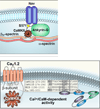Calmodulin-dependent protein kinase II: linking heart failure and arrhythmias
- PMID: 22679140
- PMCID: PMC3789535
- DOI: 10.1161/CIRCRESAHA.111.243956
Calmodulin-dependent protein kinase II: linking heart failure and arrhythmias
Abstract
Understanding relationships between heart failure and arrhythmias, important causes of suffering and sudden death, remains an unmet goal for biomedical researchers and physicians. Evidence assembled over the past decade supports a view that activation of the multifunctional Ca(2+) and calmodulin-dependent protein kinase II (CaMKII) favors myocardial dysfunction and cell membrane electrical instability. CaMKII activation follows increases in intracellular Ca(2+) or oxidation, upstream signals with the capacity to transition CaMKII into a Ca(2+) and calmodulin-independent constitutively active enzyme. Constitutively active CaMKII appears poised to participate in disease pathways by catalyzing the phosphorylation of classes of protein targets important for excitation-contraction coupling and cell survival, including ion channels and Ca(2+) homeostatic proteins, and transcription factors that drive hypertrophic and inflammatory gene expression. This rich diversity of downstream targets helps to explain the potential for CaMKII to simultaneously affect mechanical and electrical properties of heart muscle cells. Proof-of-concept studies from a growing number of investigators show that CaMKII inhibition is beneficial for improving myocardial performance and for reducing arrhythmias. We review the molecular physiology of CaMKII and discuss CaMKII actions at key cellular targets and results of animal models of myocardial hypertrophy, dysfunction, and arrhythmias that suggest CaMKII inhibition may benefit myocardial function while reducing arrhythmias.
Figures





Similar articles
-
Death, cardiac dysfunction, and arrhythmias are increased by calmodulin kinase II in calcineurin cardiomyopathy.Circulation. 2006 Sep 26;114(13):1352-9. doi: 10.1161/CIRCULATIONAHA.106.644583. Epub 2006 Sep 18. Circulation. 2006. PMID: 16982937
-
Ca2+/calmodulin-dependent protein kinase II is essential in hyperacute pressure overload.J Mol Cell Cardiol. 2020 Jan;138:212-221. doi: 10.1016/j.yjmcc.2019.12.002. Epub 2019 Dec 10. J Mol Cell Cardiol. 2020. PMID: 31836540
-
CaMKII in myocardial hypertrophy and heart failure.J Mol Cell Cardiol. 2011 Oct;51(4):468-73. doi: 10.1016/j.yjmcc.2011.01.012. Epub 2011 Jan 27. J Mol Cell Cardiol. 2011. PMID: 21276796 Free PMC article. Review.
-
The novel CaMKII inhibitor GS-680 reduces diastolic SR Ca leak and prevents CaMKII-dependent pro-arrhythmic activity.J Mol Cell Cardiol. 2018 May;118:159-168. doi: 10.1016/j.yjmcc.2018.03.020. Epub 2018 Mar 31. J Mol Cell Cardiol. 2018. PMID: 29614261
-
Ca(2+)/calmodulin-dependent protein kinase II (CaMKII) in the heart.Adv Exp Med Biol. 2012;740:685-702. doi: 10.1007/978-94-007-2888-2_30. Adv Exp Med Biol. 2012. PMID: 22453965 Review.
Cited by
-
Calmodulin kinase II regulates atrial myocyte late sodium current, calcium handling, and atrial arrhythmia.Heart Rhythm. 2020 Mar;17(3):503-511. doi: 10.1016/j.hrthm.2019.10.016. Epub 2019 Oct 14. Heart Rhythm. 2020. PMID: 31622781 Free PMC article.
-
CaMKII inhibitor KN-93 impaired angiogenesis and aggravated cardiac remodelling and heart failure via inhibiting NOX2/mtROS/p-VEGFR2 and STAT3 pathways.J Cell Mol Med. 2022 Jan;26(2):312-325. doi: 10.1111/jcmm.17081. Epub 2021 Nov 29. J Cell Mol Med. 2022. PMID: 34845819 Free PMC article.
-
Numerical Modeling Calcium and CaMKII Effects in the SA Node.Front Pharmacol. 2014 Apr 1;5:58. doi: 10.3389/fphar.2014.00058. eCollection 2014. Front Pharmacol. 2014. PMID: 24744732 Free PMC article. Review.
-
Atrial remodelling in atrial fibrillation: CaMKII as a nodal proarrhythmic signal.Cardiovasc Res. 2016 Apr 1;109(4):542-57. doi: 10.1093/cvr/cvw002. Epub 2016 Jan 13. Cardiovasc Res. 2016. PMID: 26762270 Free PMC article. Review.
-
Roles of Calcium Regulating MicroRNAs in Cardiac Ischemia-Reperfusion Injury.Cells. 2014 Sep 11;3(3):899-913. doi: 10.3390/cells3030899. Cells. 2014. PMID: 25216032 Free PMC article. Review.
References
-
- Schocken DD, Benjamin EJ, Fonarow GC, Krumholz HM, Levy D, Mensah GA, Narula J, Shor ES, Young JB, Hong Y Quality of Care and Outcomes Research Interdisciplinary Working Group; and Functional Genomics and Translational Biology Interdisciplinary Working Group. American Heart Association Council on Epidemiology and Prevention, American Heart Association Council on Clinical Cardiology, American Heart Association Council on Cardiovascular Nursing, American Heart Association Council on High Blood Pressure Research, Quality of Care Outcomes Research Interdisciplinary Working Group, Functional Genomics and Translational Biology Interdisciplinary Working Group. Prevention of heart failure: a scientific statement from the American Heart Association Councils on Epidemiology and Prevention, Clinical Cardiology, Cardiovascular Nursing, and High Blood Pressure Research. Circulation. 2008;117(19):2544–2565. - PubMed
-
- Members WG, Roger VL, Go AS, Lloyd-Jones DM, Adams RJ, Berry JD, Brown TM, Carnethon MR, Dai S, de Simone G, Ford ES, Fox CS, Fullerton HJ, Gillespie C, Greenlund KJ, Hailpern SM, Heit JA, Ho PM, Howard VJ, Kissela BM, Kittner SJ, Lackland DT, Lichtman JH, Lisabeth LD, Makuc DM, Marcus GM, Marelli A, Matchar DB, McDermott MM, Meigs JB, Moy CS, Mozaffarian D, Mussolino ME, Nichol G, Paynter NP, Rosamond WD, Sorlie PD, Stafford RS, Turan TN, Turner MB, Wong ND, Wylie-Rosett J Executive Summary: Heart Disease and Stroke Statistics--2011 Update: A Report From the American Heart Association. Committee OBOTAHAS Subcommittee SS Roger VL Turner MB Disease OBOTAHAH Group SSW. Circulation. 2011;123(4):459–463. - PMC - PubMed
-
- Lloyd-Jones D, Adams R, Brown T, Carnethon M. Executive summary: heart disease and stroke statistics--2010 update: a report from the American Heart Association. Circulation. 2010 - PubMed
-
- Krell MJ, Kline EM, Bates ER, Hodgson JM, Dilworth LR, Laufer N, Vogel RA, Pitt B. Intermittent, ambulatory dobutamine infusions in patients with severe congestive heart failure. Am. Heart J. 1986;112(4):787–791. - PubMed
-
- Echt DS, Liebson PR, Mitchell LB, Peters RW, Obias-Manno D, Barker AH, Arensberg D, Baker A, Friedman L, Greene HL. Mortality and morbidity in patients receiving encainide, flecainide, or placebo. The Cardiac Arrhythmia Suppression Trial. N. Engl. J. Med. 1991;324(12):781–788. - PubMed
Publication types
MeSH terms
Substances
Grants and funding
LinkOut - more resources
Full Text Sources
Other Literature Sources
Medical
Miscellaneous

